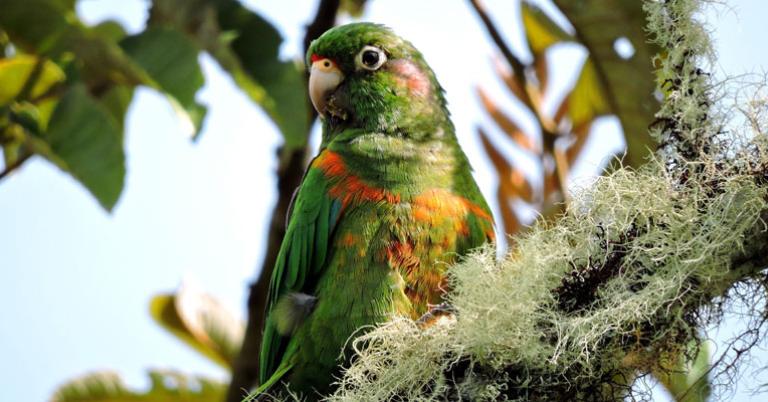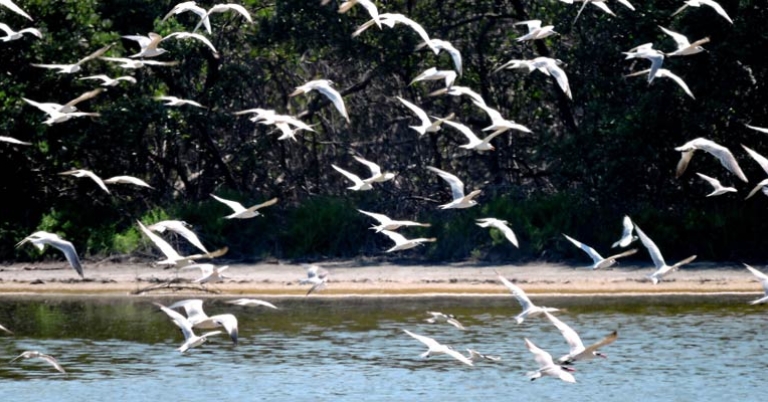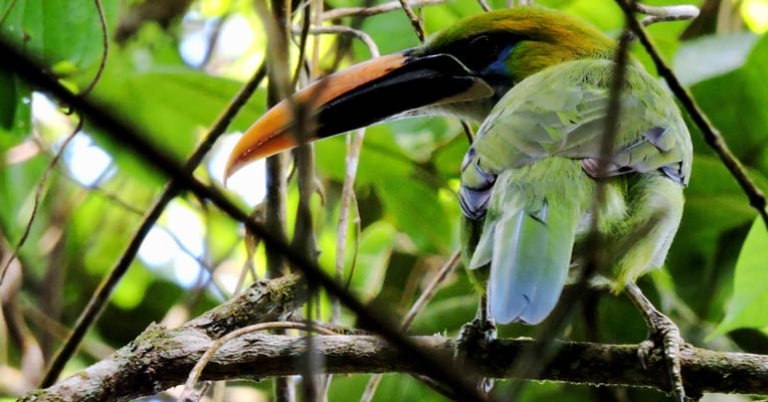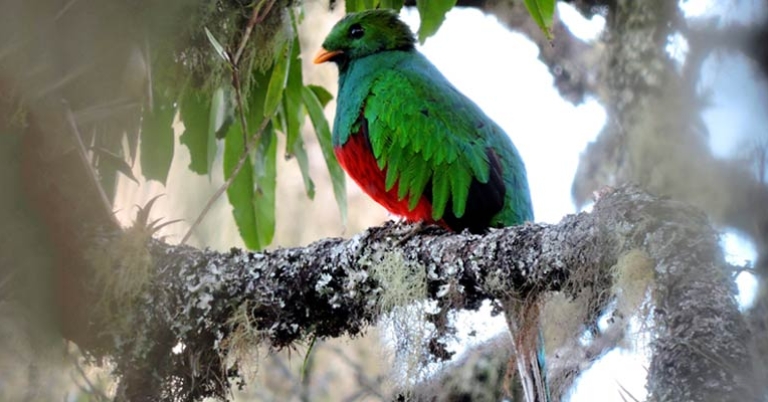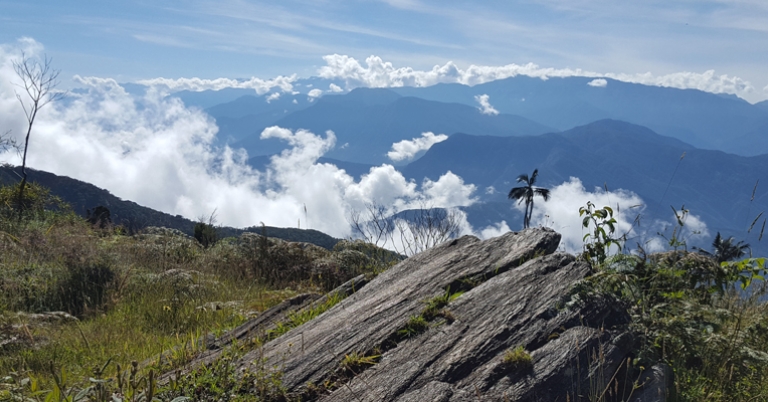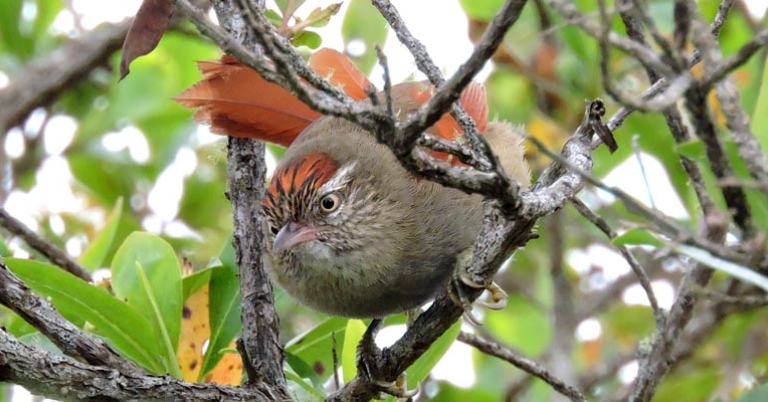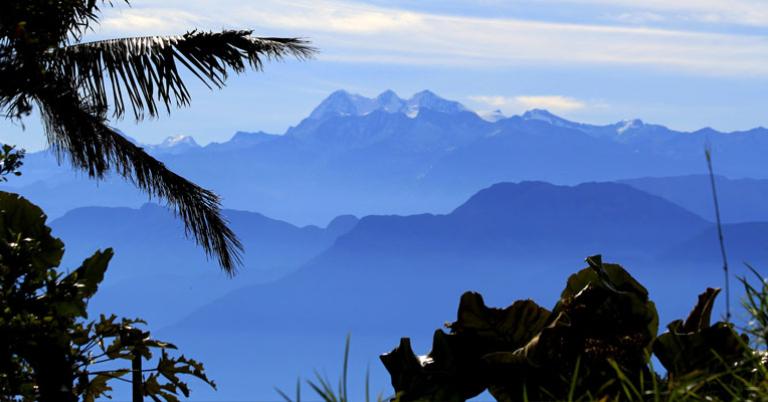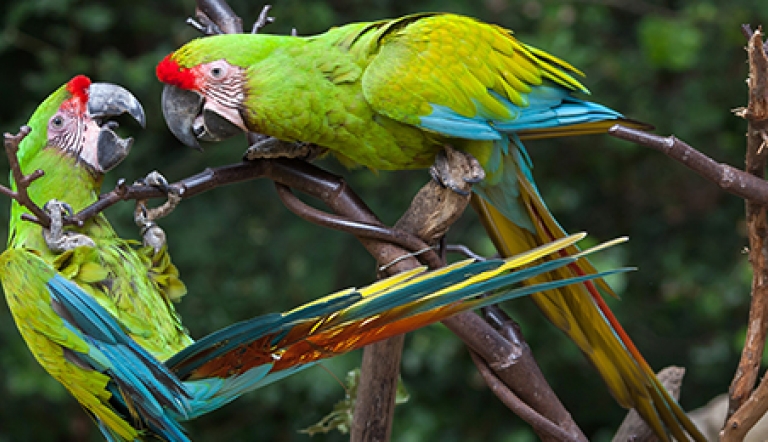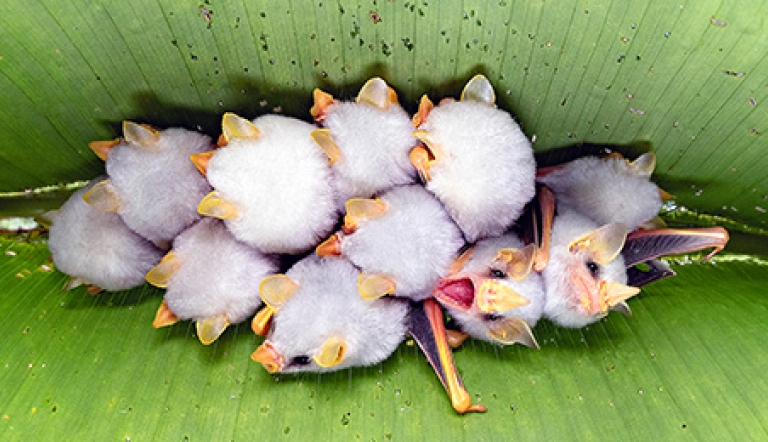Colombia | Birding the Atlantic Coast and Santa Marta Mountains
Date:
Activity Level:
Duration:
Price:
Interests:
About this trip
With over 1,900 avian species — more than any other country in the world — Colombia is a birder’s paradise waiting to be discovered. This 9-day program focuses on the country’s northern highlights, including the Caribbean region and the Santa Marta Mountains, famed for their high level of endemic species. Explore high elevation mountains, dry forest, and coastal habitats in search of an array of tropical avifauna, including flycatchers, hummingbirds, tanagers, toucans, and more. Throughout your journey, meet members of the local community and learn about conservation efforts to use birding as a sustainable development resource.
Highlights
- Discover bird-rich, remote regions of Northern Colombia, led by expert local guides.
- Bird the coastal wetland and mangrove habitats of Salamanca National Park and Los Flamencos Sanctuary along Colombia’s Caribbean coast.
- Explore the Sierra Nevada de Santa Marta, the highest coastal mountain range in the world and home to more than a quarter of the country’s endemic species.
- Meet the indigenous Wayúu people in Riohacha and learn about their culture, represented in their weaving, ceramics, flora, and gastronomy.
$3,870
Per person
About this price
Land cost only. Does not include round-trip airfare to and from destination.
Single room supplement $375
What makes us different
Scopes
Wildlife up-close
Service anytime
Top birding guides
Meaningful experiences
Expert guides
Daily Itinerary
Print ItineraryBarranquilla
Riohacha
Riohacha
Santa Marta
Sierra Nevada de Santa Marta
Sierra Nevada de Santa Marta
Sierra Nevada de Santa Marta
Barranquilla
Depart
Pricing
Print Pricing$3,870
Per person
About this price
Land cost only. Does not include round-trip airfare to and from destination.
Single room supplement $375
What's Included
- Activities and meals as mentioned in itinerary
- Full time expert birding naturalist guide for duration of program
- Private transportation and driver for the duration of the program
- Arrival and departure transfers based on individual flight schedules
- Non alcoholic beverage with meals
- Bottled water or water refill station during transfers
- Carbon Offset
What's Not Included
- International airfare
- Tips
- Travel Insurance
- Items of personal nature
Pricing Details
A deposit of $350 is required for participants to register and reserve space on the program. Reservations submitted beyond the final payment deadline noted below will require full payment to enroll. 120 or more days before departure: $100 cancellation fee; remaining balance is refunded. 119 - 96 days before departure: full deposit of $350 is forfeited. 95 - 0 days before departure: 100% of program price is forfeited.
Holbrook Travel strongly recommends the purchase of travel protection for medical emergencies while traveling and to protect your investment. Please note the purchase of Cancel for Any Reason Coverage or to exclude pre-existing conditions with Trip Cancellation coverage may require policy purchase within 10-14 days of your initial deposit, depending upon the provider.
Single room supplement $375
Final payment due date: November 15, 2025
Travel Info
Print Travel InfoEntry & Exit Requirements
U.S. citizens must present a passport valid for at least the duration of their stay to enter Colombia.
A Colombian visa is not required for tourist stays of 90 days or less. Travelers entering Colombia are sometimes asked to present evidence of return or onward travel, usually in the form of a plane ticket.
No arrival tax is collected upon entry into Colombia, but travelers leaving by plane must pay an exit tax in cash at the airport. Most airlines include all or a portion of this fee in the cost of your airline ticket. Check with your airline beforehand to find out how much you will have to pay at the airport.
If you are not traveling with a U.S. passport, please check with the Colombian Embassy for the requirements based on your nationality.
Health and Safety
Please consult your physician for guidance on medical issues. Holbrook Travel is not authorized to provide medical information and the following advice should be confirmed with your doctor.
Immunizations
The Centers for Disease Control recommends that all travelers be up-to-date on routine vaccinations such as measles-mumps-rubella (MMR) vaccine, diphtheria-pertussis-tetanus vaccine, varicella (chicken pox) vaccine, and your yearly flu shot, as well as the COVID-19 vaccine, before every trip.
There are no vaccinations required for entry into Colombia (unless you are arriving from Angola, Brazil, Democratic Republic of the Congo, or Uganda, in which case yellow fever vaccine is required). According to the CDC, yellow fever is a risk in much of Colombia. While not required for entry into the country, the CDC does recommend the yellow fever vaccine for most travelers.
Additionally, the CDC recommends vaccination against hepatitis A, hepatitis B, and typhoid for most unvaccinated travelers to Colombia.
Please visit cdc.gov/travel or consult your physician for additional information and recommendations based on your individual circumstances.
Malaria
The CDC warns that travelers to Colombia may be at risk for exposure to malaria, especially at elevations below 5,600 feet. Malaria is caused by a parasite found in Anopheles mosquitos, which are active from dusk until dawn. Prevention is twofold: the use of anti-malarial drugs and the prevention of insect bites. If you choose to use an anti-malarial drug, as recommended by the CDC, see your physician for a prescription. To protect against mosquitos, cover exposed skin with lightweight, long-sleeved shirts and pants, consider treating clothes with permethrin, and use an insect repellent containing an active ingredient like DEET or picaridin. Apply sunscreen first, followed by the repellent (preferably 20 minutes later).
Other Insect-borne Illnesses
Other insect-borne illnesses are known to occur in Colombia, including dengue fever, leishmaniasis, Zika virus, and others. Travelers to Colombia should protect themselves against insect bites using the measures described above.
As a precaution, the CDC advises women who are pregnant to consider postponing travel to any area where Zika virus transmission is ongoing.
Altitude sickness
Upon arrival at locations of high elevation (above 5,000 feet), shortness of breath and a pounding heart are normal responses to the lack of oxygen in the air. However, for some visitors, these symptoms can deteriorate into altitude sickness. Headache, extreme tiredness, dizziness, nausea, and loss of appetite are standard symptoms. Staying hydrated and well rested is important to adjust to the altitude. Avoiding heavy, fatty foods and alcohol in the days before arriving to altitude can help. Over-the-counter medications are also available to help prevent or alleviate symptoms. It’s advisable to avoid sleep medications, as they can slow breathing and respiration, which aid in getting the blood oxygenated while sleeping. Participants who take blood pressure medications should discuss this with their doctor as the medication can drop pressure too low at times.
SUN EXPOSURE
The effects of the sun can be damaging to the eyes and skin. Spending time outdoors exposes you to the sun’s harmful ultraviolet (UV) rays, even on cloudy days. To protect yourself from the sun, use a broad spectrum sunscreen of at least SPF 15, protect skin with clothing, wear a wide-brimmed hat and sunglasses, and drink plenty of fluids.
Resources
Print ResourcesPacking Recommendations
Everyone has personal preferences when it comes to packing; for this reason, the information below is offered as a general guide and not a definitive list. You know yourself best: Use your discretion and pack what you think will serve you, based on your personal preferences and specific itinerary.
You may find many of the items below in the New Headings Gear Store. Use code HolbrookGuest10 for a 10% discount on your purchase.
CLOTHING
Bring enough clothing suitable for the length of your program. If you prefer to pack light, note that many hotels offer laundry services at additional cost. If you plan to hand-wash items, remember that humidity may delay drying time.
This itinerary visits a variety of habitats and elevations, from sea level up to 7,500 feet. Pack clothing that can be worn in layers to adapt to weather changes throughout the day and at varying elevations. At higher elevations, warm clothing is recommended. Temperatures can be cool, especially at night and early in the morning. Consider packing a warm underlayer, as well as a warm, protective outer layer.
- A combination of short- and long-sleeved shirts that can be worn in layers, including lightweight long-sleeved shirts for sun and mosquito protection
- Shorts
- Long pants – Jeans, trousers, and/or lightweight, quick-drying long pants for sun and mosquito protection
- Undergarments
- Sleepwear
- Jacket or sweater/sweatshirt
- 1-2 bathing suit(s)
- Socks – Bring extra pairs.
- Shoes – You’ll likely want at least one pair of comfortable, closed-toe walking or hiking shoes or boots suitable for forest hikes and walking over cobblestones or other uneven terrain. In addition, many participants opt for a pair of sturdy sport-strap sandals (e.g. Keens, Tevas, or similar) and/or casual flip-flops or sandals for the beach and around the hotel. You may also want a pair of aqua socks, reef walkers, or water shoes for the beach.
- Lightweight rain jacket, hooded poncho, and/or windbreaker
- Visor or wide-brimmed sun hat
- Bandana, scarf, or gaiter
Personal Toiletries
Pack toiletries based on your personal preferences and habits. Below are just a few recommendations to keep in mind.
- Shampoo, conditioner, lotion, deodorant/antiperspirant , etc. – If possible, avoid strong fragrances if you are sensitive to insect bites and in consideration of your fellow travelers.
- Soap and washcloth or a small, quick-drying microfiber towel – Washcloths are not standard in all hotels. If you normally use a washcloth, you may wish to bring one from home.
- Hairbrush, comb, hair ties, shower cap
- Toothbrush and toothpaste
- Razor
- Ear plugs, especially if you are a light sleeper
- Personal hygiene products
- Insect repellent with DEET or picaridin
- Sunscreen and lip balm with SPF – If you’ll be in the ocean, we recommend reef-safe sunscreen.
- Aloe vera gel
- A travel pack of tissues – also useful as napkins or toilet paper if needed
In addition to your personal toiletries, it is useful to pack a small medical kit, which you can easily prepare. Helpful items might include: bandages, antihistamine, a pain reliever, motion sickness and/or altitude sickness medication (if you are prone to either), anti-diarrhea medicine, individually wrapped pre-moistened towelettes and/or hand sanitizer, antibiotic ointment, anti-fungal cream, moleskin for blisters, eye drops, tweezers, a mini sewing kit, and an extra pair of disposable contact lenses or eyeglasses if you wear them.
Days before you leave home, you may wish to consider spraying any clothing, socks, and shoes that will be worn in lowland, tropical sites with permethrin, an anti-parasite medication, to repel irritating pests and prevent the spread of disease. A recommended brand is Sawyer. Carefully read all instructions before use. Please note permethrin is highly toxic to cats and fish, and some aerosol products may be harmful to birds. Side effects may include minor itching, burning, or redness. You may want to use a laundry marker to label and keep track of which socks are permethrinized. Only one application per item is necessary; permethrin on treated clothes remains effective through several washings. Permethrin should NOT be applied directly to skin.
Miscellaneous
Remember to pack valuables such as your passport, cash/credit cards, and medications in your carry-on luggage.
- Passport and photocopies of all travel documentation
- Personal insurance card and travel insurance information
- Money – ATM/credit card, and/or cash; small bills in good condition are recommended
- Prescription medicines (if applicable), with a copy of the prescription
- Yellow fever certificate (if applicable; see Travel Info tab)
- Sunglasses with strap
- Small day pack for hikes and excursions
- Flashlight and/or head lamp
- Travel alarm clock or inexpensive waterproof wristwatch with alarm – Not all hotels provide alarm clocks.
- A pocket calculator or phone to assist with conversions and currency exchange
- Binoculars with lens cleaner
- Camera and related equipment, such as charger, lenses, and extra memory cards
- Reusable water bottle
- Non-perishable snacks
- Pocket-knife or multipurpose tool - Pack in your checked luggage
- Zip-top style bags – useful for packing toiletries, sorting clothing, storing damp or muddy shoes, or as a dry bag for protecting electronics
- Notepad or travel journal and pen
- Music or reading material for down time, long bus drives, or on the airplane, and a portable bright light to read by
- Collapsible walking stick with rubber tip
- A small quantity of laundry detergent if you’ll be washing clothing by hand
- Travel-size umbrella – Some people find this unwieldy to carry, while others find it offers better protection than a rain jacket alone.
- Money belt
- Chargers for electronics

Questions
For more information, contact Kevin Van Dien at kevin@holbrooktravel.com or 800-451-7111 x312
